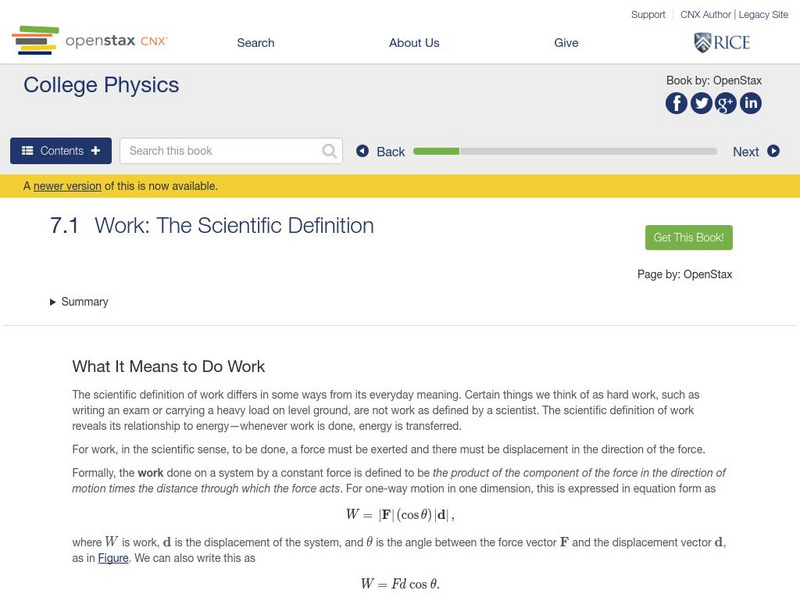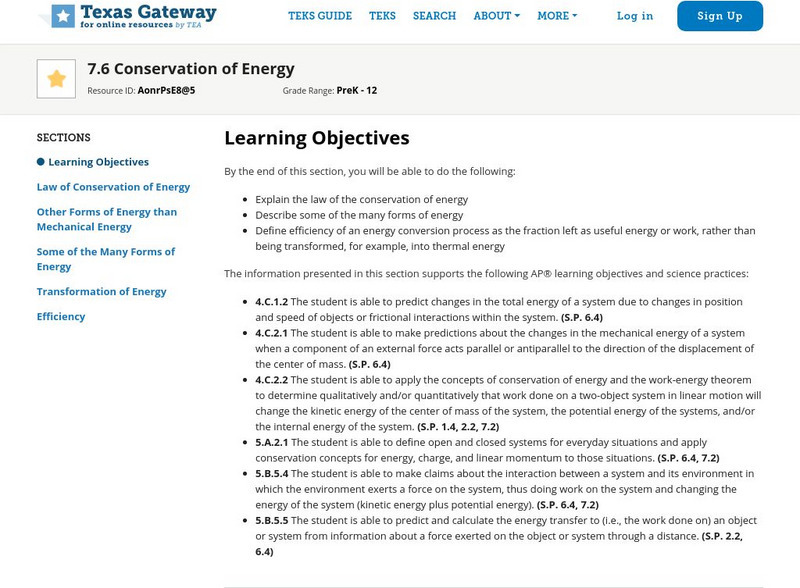OpenStax
Open Stax: Work, Energy, and Power in Humans
In the following interactive students will begin to explain the human body's consumption of energy when at rest vs. when engaged in activities that do useful work. They will also calculate the conversion of chemical energy in food into...
OpenStax
Open Stax: Potential Energy and Conservative Forces
In the following interactive students will define conservative force, potential energy, and mechanical energy. They will explain the potential energy of a spring in terms of its compression when Hooke's Law applies. Students will also...
CK-12 Foundation
Ck 12 Exploration Series: Simulations: Physics: Block and Tackle
[Free Registration/Login Required] A video module where students learn about the relationship between force, work, energy, and mechanical advantage using a simple machine.
CK-12 Foundation
Ck 12: Conservation of Energy
[Free Registration/Login may be required to access all resource tools.] Students investigate how all types of energy, including work, relate to each other and are conserved in a closed system.
OpenStax
Open Stax: Work: The Scientific Definition
In the following interactive students will begin to explain how an object must be displaced for a force on it to do work. They will also explain how relative directions of force and displacement determine whether the work done is...
Georgia Department of Education
Ga Virtual Learning: Special Relativity and Quantum Mechanics
In this interactive tutorial students explore special relativity and quantum mechanics. Learn basic tenets of the theory of special relativity and the relationship between mass and energy. Also discover the evidence for the particle...
Physics Classroom
The Physics Classroom: Work, Energy, and Power: Calculating Work Done by Forces
Through interactive practice problems and examples, students calculate the amount of work done by forces.
Texas Education Agency
Texas Gateway: Kinetic Energy and the Work Energy Theorem
By the end of this section, you will be able to explain work as a transfer of energy and net work as the work done by the net force and to explain and apply the work-energy theorem.
Cosmo Learning
Cosmo Learning: Physics I: Classical Mechanics
A collection of video lectures from a classic mechanics course taught at the Massachusetts Institute of Technology. The course teaches modern physics, thermal physics, fluid mechanics, solids mechanics, celestial mechanics, momentum,...
Texas Education Agency
Texas Gateway: Rotational Motion and Angular Momentum: Summary
This page provides a summary of each section in Chapter 10: Rotational Motion and Angular Momentum from the AP Physics online text.
Physics Classroom
The Physics Classroom: Chart That Motion
This activity is an online, interactive energy bar chart tool that assesses student understanding of the work/energy relationship.
Khan Academy
Khan Academy: Work Can Be Negative!
Understand that work, a measurement of energy, can be negative.
Khan Academy
Khan Academy: What Is Kinetic Energy?
Learn what kinetic energy means and how it relates to work.
Khan Academy
Khan Academy: What Is Thermal Energy?
Learn what thermal energy is and how to calculate it.
Khan Academy
Khan Academy: What Is Elastic Potential Energy?
This site explains and gives examples of elastic potential energy and how to calculate it.
Georgia State University
Georgia State University: Hyper Physics: Potential Energy
This site from Georgia State University Physics Department defines and explains the concept of potential energy. Using equations and graphics to illustrate the idea, it discusses the many types of potential energy (gravitational,...
Georgia State University
Georgia State University: Hyper Physics: Kinetic Energy
This site from Georgia State University Physics Department defines kinetic energy and compares and contrasts it with other forms of energy. Provides an equation and links to further, more-detailed information.
Physics Classroom
The Physics Classroom: Work, Energy, and Power: Mechanical Energy Is Conserved
In this interactive exercise, explore the quantitative relationship between work and mechanical energy in situations in which there are no external forces doing work.
Physics Classroom
The Physics Classroom: Work, Energy, and Power: Application/practice Questions
Through illustrated examples and practice problems, students apply the relationship between work and mechanical energy change to a variety of motion scenarios in order to test our understanding.
Texas Education Agency
Texas Gateway: Ap Physics: Conservation of Energy
By the end of this section, you will be able to explain the law of the conservation of energy; describe some of the many forms of energy; and define efficiency of an energy conversion process as the fraction left as useful energy or...
Nobel Media AB
The Nobel Prize: The Nobel Prize in Physics 1918: Max Planck
Use this site to learn about the scientific work of physicist, Max Planck (1858-1947 CE), whose studies in radiation and light earned him the 1918 Nobel Prize in Physics. Read his Nobel Lecture, "The genesis and present state of...
Khan Academy
Khan Academy: What Is Physics?
Article attempts to answer the question "what is Physics?" Takes a look at concepts such as force, motion, Newton's Laws, work, energy, and much more.
Yale University
Open Yale Courses: Fundamentals of Physics
Intended for students with a strong math and science background, a course introducing physics concepts of Newtonian mechanics, special relativity, gravitation, thermodynamics, and waves. Twenty-four class sessions in video format are...
CK-12 Foundation
Ck 12: Physics: Energy Study Guide
Understand and review energy concepts with this study guide.

















